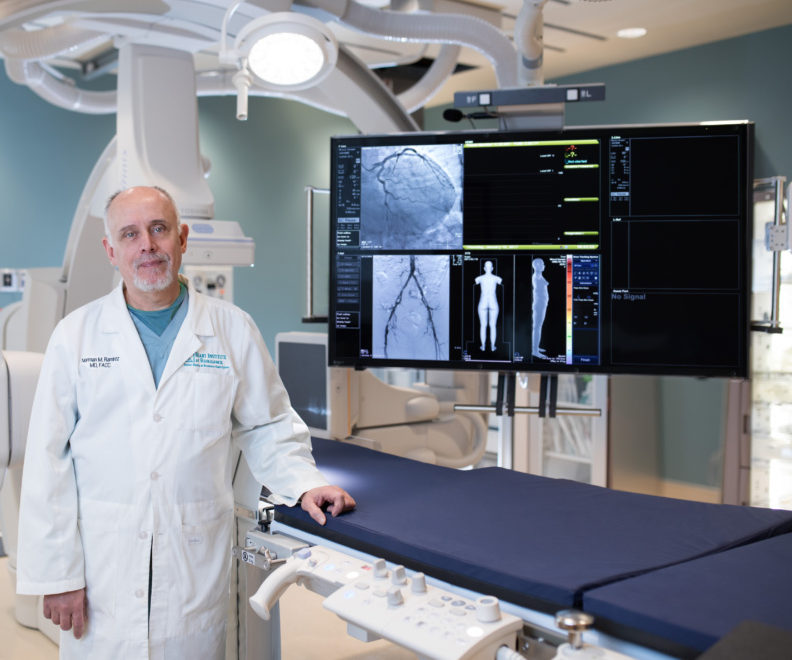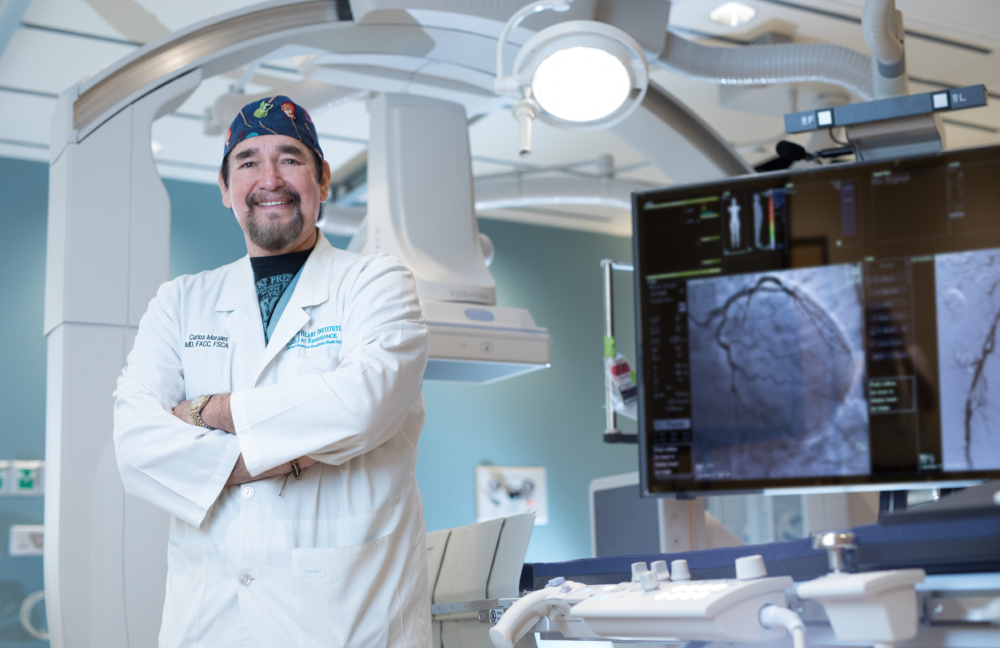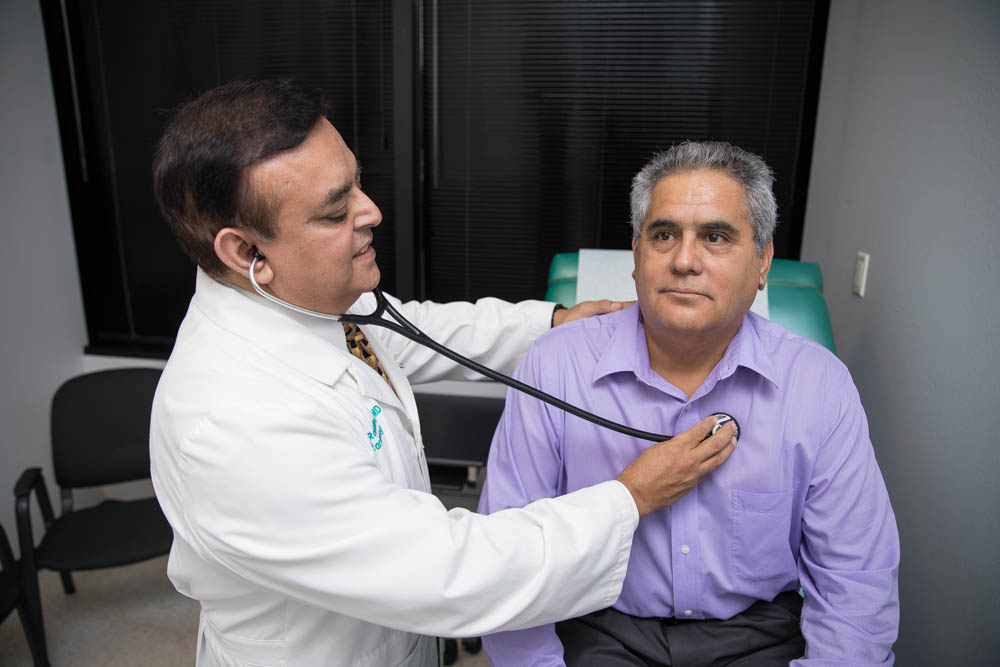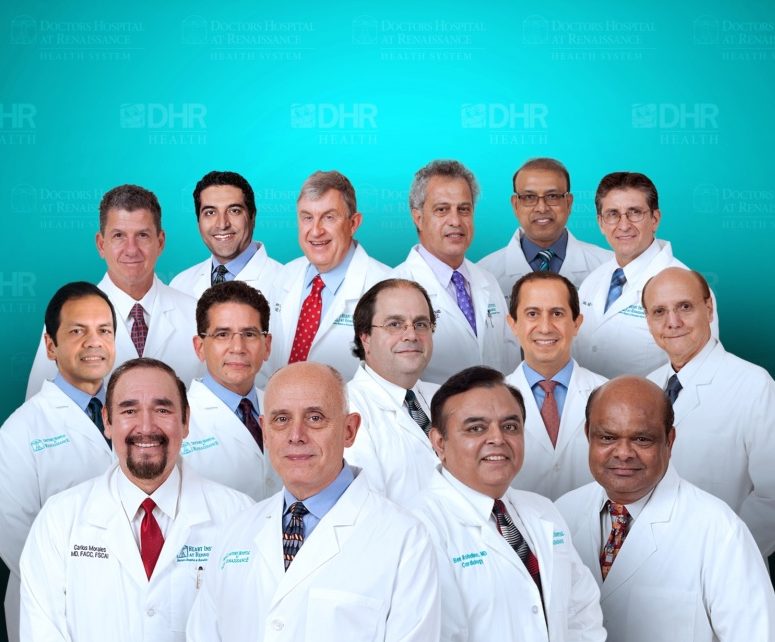Special to MD Monthly
Cardiologists at Doctors Hospital at Renaissance are saving lives through a less invasive medical procedure known as transcatheter aortic valve replacement (TAVR).
Dr. Norman Ramirez, Dr. Carlos Morales and Dr. Benjamin Robalino of the Heart Institute at Renaissance perform this life-saving procedure for patients at high risk for open heart surgery. They have performed more than 50 TAVR procedures since launching the program in August 2016.
 “It’s convenient for patients because they don’t have to have their chests cut open or leave the city for surgery,” Dr. Morales said. “They go home three days after having the procedure. We’re proud of the fact that we’re the only hospital in South Texas doing TAVR.”
“It’s convenient for patients because they don’t have to have their chests cut open or leave the city for surgery,” Dr. Morales said. “They go home three days after having the procedure. We’re proud of the fact that we’re the only hospital in South Texas doing TAVR.”
Dr. Norman Ramirez has performed 42 TAVR procedures in the last several months. “I’ve been practicing medicine for 30 years, so it’s exciting to learn new techniques,” he said. “TAVR can be a life-saving treatment for people at high risk for open heart surgery.”
Dr. Ramirez knows all about saving lives in the Rio Grande Valley, where he was raised. He implanted the first defibrillator in a patient there in 1989 and also performed the first TAVR procedure at Doctors Hospital at Renaissance. It was his father, a physician who treated many of the poor in his hometown of Roma and from Mexico, he said, who inspired him to practice medicine.
“We’re proud of the fact that we’re the only hospital in South Texas doing TAVR.” – Dr. Carlos Morales
“He used to make house calls, and I would drive him,” Dr. Ramirez said. “He delivered hundreds of babies and now I take care of all their children.”
Dr. Ramirez recalls leaving home for the first time at age 16 and landing at New York’s La Guardia airport to begin college at Yale University. “People say you can’t get a good high school education in the Rio Grande Valley, but I graduated from Yale magna cum laude and in the top of my class at Stanford University Medical School,” he said.
After completing his cardiology training at Duke University School of Medicine, he was on staff at the Mayo Clinic before deciding to return home to care for patients in his community. “I missed home and my family,” Dr. Ramirez said, “and I realized I could do things in the Valley that weren’t going to get done otherwise. My training had been quite extensive, so I took my skills back home and started doing procedures that had never been done here before.”
According to the American Heart Association, the TAVR procedure is somewhat similar to a stent placed in an artery. It delivers a fully collapsible replacement valve to the valve site through a catheter. Once the new valve is expanded, it pushes the old valve leaflets out of the way and the tissue in the replacement valve takes over the job of regulating blood flow.
 The TAVR procedure is performed using one of two different approaches, allowing the cardiologist to choose which one provides the best and safest way to access the valve: Entering through the femoral artery (large artery in the groin), which does not require a surgical incision in the chest or using a minimally invasive surgical approach with a small incision in the chest and entering through a large artery in the chest, or through the tip of the left ventricle.
The TAVR procedure is performed using one of two different approaches, allowing the cardiologist to choose which one provides the best and safest way to access the valve: Entering through the femoral artery (large artery in the groin), which does not require a surgical incision in the chest or using a minimally invasive surgical approach with a small incision in the chest and entering through a large artery in the chest, or through the tip of the left ventricle.
“I’ve been practicing medicine for 30 years, so it’s exciting to learn new techniques.”- Dr. Norman Ramirez
Dr. Morales explained that candidates for TAVR are evaluated by two surgeons who determine whether a patient is too high risk for open heart surgery because of advanced age “or other vulnerabilities.”
Dr. Morales has been a cardiologist since 1983 and said he still wakes up excited every day to treat patients and teach internal medicine residents at the University of Texas Rio Grande Valley.
“Teaching is part of my job,” he said. “It’s necessary that we teach future generations of physicians and cardiologists.”
Dr. Benjamin Robalino specializes in cardiovascular disease, and is a member of the TAVR team at Doctors Hospital at Renaissance. After graduating from Cayetano Heredia University in Peru, Dr. Robalino has spent more than 25 years serving the needs of people suffering from heart disease and related ailments.
If you were to ask him what he does, he may boil down the definition a bit.
“I do interventional cardiology, a sort of heart plumbing,” Dr. Robalino says. “We treat the narrowing of the heart and peripheral circulation.”
 Dr. Robalino is affiliated with Doctors Hospital at Renaissance, which offers the premier cardiovascular program in the Rio Grande Valley through its Heart Institute at Renaissance. Physicians at the Heart Institute at Renaissance perform many specialized procedures not available at other regional medical facilities.
Dr. Robalino is affiliated with Doctors Hospital at Renaissance, which offers the premier cardiovascular program in the Rio Grande Valley through its Heart Institute at Renaissance. Physicians at the Heart Institute at Renaissance perform many specialized procedures not available at other regional medical facilities.
Dr. Robalino says he’s proud to be part of a group of cardiologists who have served the area for so long.
“Better service, more efficient service, less waiting time — that was basically the idea behind the formation of the Heart Institute at Renaissance,” Dr. Robalino says.
Efficiency and a focus on cardiology and vascular care counts in many ways in the Rio Grande Valley. Poor health around the Valley has been well noted in recent years. The region’s rate of diabetes was recorded as being 20 percent higher than that of all of Texas in 2013.
In the same year, nearly one in three Valley residents was diagnosed as diabetic.
“This area has a disproportionate number of people with diabetes,” Dr. Robalino says. “Plus, the population has an aggressive form of vascular disease.”
He explains that many Rio Grande Valley residents are being diagnosed with diabetes and/or vascular disease at an earlier age, with some ending up on dialysis. Actually, there are two populations emerging in the Valley’s health care scene these days. One is the native/local population, mostly Hispanics and Latinos who face cardiovascular diseases because of high blood pressure, obesity and diabetes.
The other population is the group of “Winter Texans” — Northerners and Canadians who head to Texas for the winter. These mostly elderly people already are diagnosed with cardio or vascular disease.
While February is American Heart Month, physicians at the Heart Institute at Renaissance say it’s important for everyone to balance prevention and awareness to fight heart disease, or to reduce the risk, year-round.
“Better service, more efficient service, less waiting time — that was basically the idea behind the formation of the Heart Institute at Renaissance.” – Dr. Benjamin Robalino
“People are much more informed about cardiac disease now than they were 20, 30, 40, 50 years ago,” Robalino says. “Think back to, say, 1950-1955. Nobody then knew smoking could lead to cancer, cardiovascular disease or stroke. If people aren’t aware that smoking can lead to cancer, cardiovascular disease or stroke, that’s already a bad start to life.”
Dr. Robalino says prevention or coping can come in the form of exercise and proper diet. For example, 30 minutes of continuous walking, five times a week, is a good start for many people. He recommends limiting salt intake, regularly monitoring one’s blood pressure and cholesterol, and not smoking for better heart and vascular health.
“There’s no particular cardiac diet that’s better than another,” he says. “As for exercise, it’s the base for prevention as long as you don’t smoke. Otherwise, you can’t control it.”
As for cholesterol, Dr. Robalino agrees with other physicians and research that it’s best to keep bad cholesterol low and keep good cholesterol at an adequate level.
“This is a lifelong commitment to the situation,” he says. “People need to understand (the disease) will never go away.”
The Heart Institute at Renaissance is affiliated with Doctors Hospital at Renaissance Health System. The institute has locations in Brownsville, Rio Grande City, Edinburg and McAllen. For more information, visit www.dhr-rgv.com.







Recent Comments